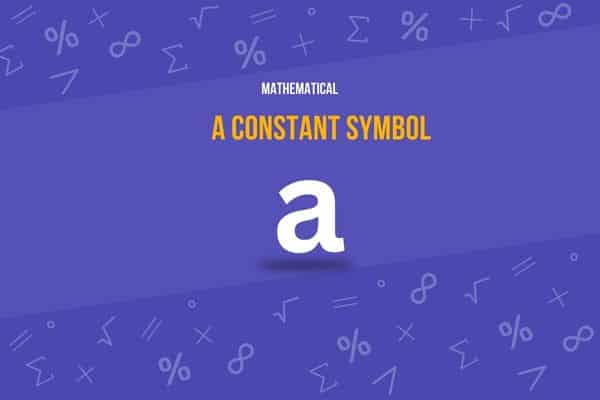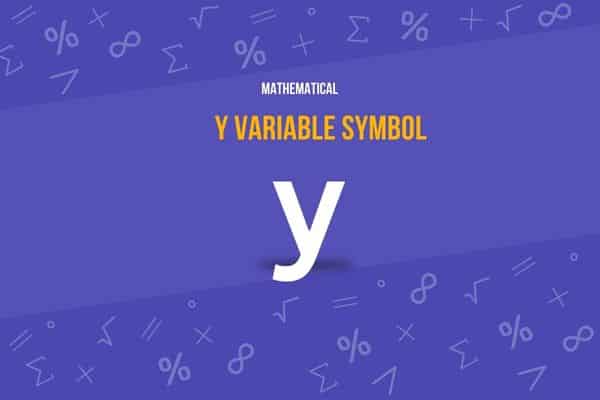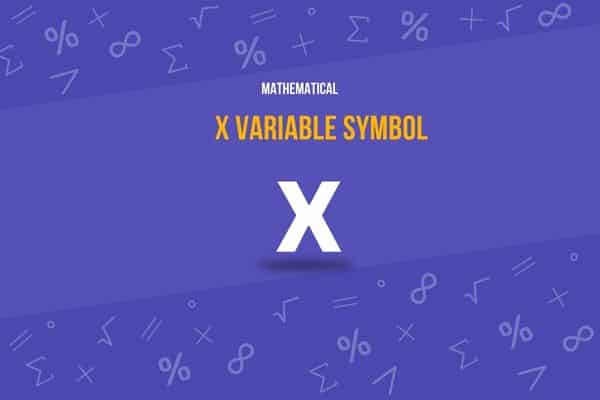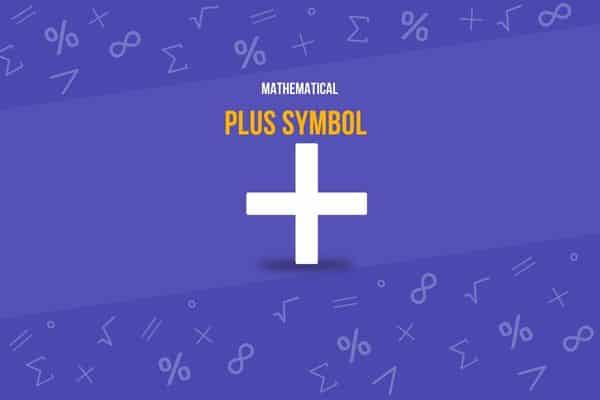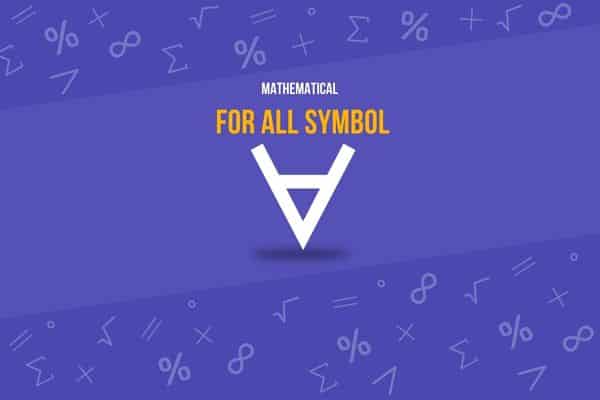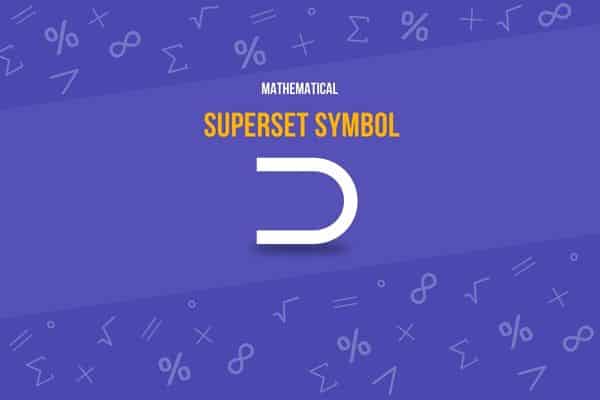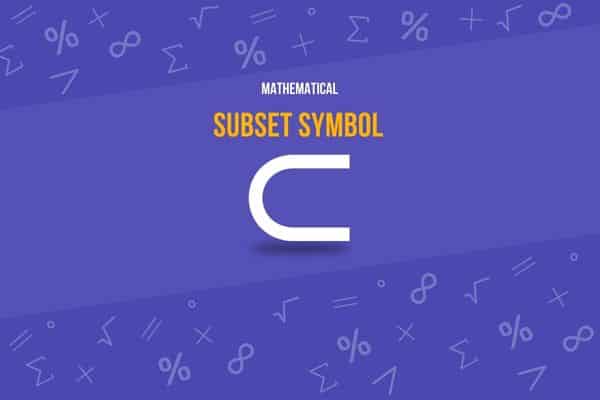Are you a math enthusiast curious about the role of algebra symbols in mathematical equations? Have you ever wondered what ‘b’ signifies in a linear equation?
This article will unravel the significance and application of ‘b’ in our mathematical journey. You’ll understand clearly how ‘b’ impacts algebraic expressions and shapes our understanding of mathematics.
Reading this article will offer valuable insight into mathematical symbols, providing practical knowledge for your studies or career.
So, are you ready to understand the unsung hero of algebraic expressions? Continue reading to unlock the world of ‘b’ and its importance in mathematics.
Rest assured, you’re in the right place to satisfy your curiosity about the b constant and its role in mathematics.
Let’s get started!
Fast Facts
b
B Constant
B Constant Symbol Overview
Here is a comprehensive table with detailed information about the b constant symbol as used in mathematical contexts:
| Attribute | Details |
|---|---|
| Symbol Name | B Constant |
| Unicode | U+0042 |
| Image | B |
| Brief Description | Represents a constant value in mathematical equations and formulas. |
| Unicode Version and Date | Unicode 1.1, June 1993 |
| Unicode Block Name | Basic Latin |
| Plane | BMP (Basic Multilingual Plane) |
| Script | Latin |
| Category | Uppercase Letter |
| Bidirectional Class | Left-to-Right (L) |
| Combining Class | 0 (Not a combining character) |
| Character is Mirrored | No |
| HTML Entity | B or &B; |
| CSS | \0042 |
| UTF-8 Encoding | 42 |
| UTF-16 Encoding | 0042 |
| UTF-32 Encoding | 00000042 |
Here’s What You Will Find
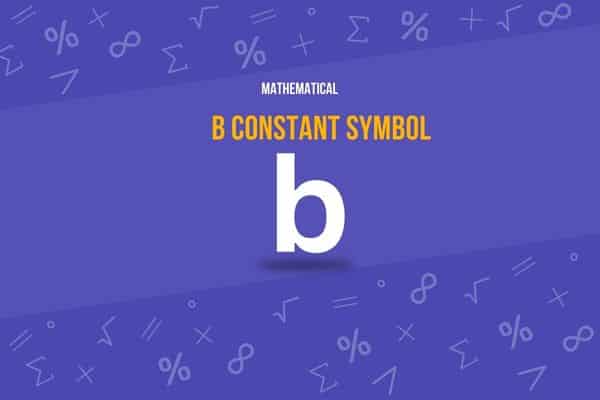
All About the B Constant Symbol
You might be wondering, what’s the ‘b constant symbol’ in algebra?
Let’s get into its meaning, understand its significance, and explore other names it’s known by.
We’ll also discuss the organizations that regulate it to give you a full picture of this important mathematical symbol.
What is the B Constant Symbol?
Have you ever wondered about the role of the b constant symbol in algebra? The b constant symbol is crucial in algebraic expressions and equations. Think of it as a placeholder. It’s like a variable, but unlike variables, it doesn’t change. It’s a fixed number, a constant, hence its name.
The b constant symbol in mathematics is used as one of the standard algebra symbols to represent a fixed value or parameter within equations. Commonly seen in polynomial expressions, algebraic equations, and various formulae, the “b” symbol typically denotes a known quantity that remains constant across specific calculations, distinguishing it from variables that can change value depending on the context of the problem. Algebra is often paired with constants like a and c to outline relationships and structures within mathematical models and theories.
You’ll often find it in linear equations, where it represents the y-intercept, but that’s getting ahead of ourselves. Understanding that ‘b’ isn’t just a letter but a symbol with a specific role in the mathematical world is important. It’s part of the language of algebra, which allows you to express complex ideas in a simplified form.
What does the B Constant Symbol Mean?
Let’s illuminate its meaning in detail by building on the understanding that the b constant symbol is a fundamental part of algebraic notation.
You’ve probably seen ‘b’ in equations like y = mx + b. Here, ‘b’ is the y-intercept. It’s the point where the line crosses the y-axis.
But don’t box ‘b’ into one function. In a broader sense, ‘b’ stands for any constant in an equation. It’s a placeholder, a free spirit that can take on any value, depending on the equation’s context.
Understanding the Meaning of the B Constant Symbol
Let’s explore the b constant symbol, a key player in algebra that can assume any value depending on the context of the equation. You’re free to assign ‘b’ any numerical value you deem fit, whether it’s negative, positive, or zero.
It’s your journey into the algebra domain, and ‘b’ is your faithful companion, adapting to your needs. This flexibility is the strength of ‘b’. It’s a chameleon, changing to suit the equation’s demands.
Other Names
While ‘b’ is the commonly used symbol, it can also be referred to by other names in different mathematical contexts or equations.
For instance, you might encounter it as ‘beta’ in Greek letters or as ‘second coefficient’ when dealing with quadratic equations. In some areas of mathematics, ‘b’ can also be called the ‘slope’ or ‘gradient’ in linear equations.
When exploring trigonometry, it might even be called the ‘amplitude’. It’s all about understanding the context of the equation you’re working with.
Organizations Regulating the B Constant Symbol
Moving on from the various names of the b constant symbol, you must know the organizations that regulate its use in mathematical notation. These include the International Mathematical Union (IMU) and the American Mathematical Society (AMS). They’re responsible for ensuring the consistency and comprehensibility of mathematical symbols. They’re like the guardians of freedom in the mathematical world, allowing ideas to be communicated without hindrance.
It’s not just about rules but about providing a universal language for mathematical exploration. However, these organizations don’t arbitrarily impose restrictions. They respect the rights of mathematicians to express unique concepts, using new symbols when necessary. They simply maintain a balance between freedom and understanding.
How to Use the B Constant Symbol
Using the b constant symbol in algebraic equations can simplify your mathematical journey. Think of ‘b’ as your wildcard, your free spirit within the confines of equations. It’s a constant but also an opportunity for you to dictate the terms.
The b constant symbol is crucial in various mathematical contexts, particularly in algebra and related disciplines. Its primary function is to represent a fixed value or parameter that does not change within the scope of a given problem or equation. Understanding how to use this symbol effectively can enhance your problem-solving capabilities and clarify mathematical communication. Here are some detailed guidelines on how to use the b constant symbol across different mathematical applications:
Polynomial Equations
In polynomial equations, “b” often appears as a coefficient that influences the shape and properties of the polynomial curve. It provides a specific numerical multiplier for one of the terms in the equation.
Example:
In the quadratic equation ( ax^2 + bx + c = 0 ), “b” is the coefficient of the linear term ( x ). Its value affects the slope of the tangent to the vertex of the parabola described by the equation.
Formulas in Physics and Engineering
“b” is frequently used in physics and engineering to denote constants that describe physical properties or coefficients in formulas. These constants can define forces, resistances, magnetic fields, and other physical parameters.
Example:
In the formula for the force exerted by a magnetic field, given by F=B×I×L, where ( I ) is the current and ( l ) is the length of wire in the magnetic field, “b” represents the magnetic field strength, a constant that determines the magnitude of the force.
Statistical Models
In statistical modeling, particularly in regression analysis, “b” is often used to represent the slope coefficients of predictor variables. These coefficients are constants derived from data to predict or explain outcomes.
Example:
In a simple linear regression model y=α+βxy=α+βx, “b” or β is often denoted as “b”, representing the slope of the line, indicating how much the dependent variable ( y ) changes for a unit change in ( x ).
Geometry
In geometry, “b” can represent a specific constant measurement, such as a triangle’s base length or the rectangle’s breadth. These measurements are crucial for calculating areas, volumes, and other geometrical properties.
Example:
In the formula for the area of a rectangle, ( A = l \times b ), “b” could be used to denote the breadth (( b )), which, along with the length (( l )), determines the rectangle’s area.
Theoretical Mathematics
In more abstract areas of mathematics, such as group theory or topology, “b” might represent a particular set, group, or other mathematical structures that play a key role in theoretical explorations.
Example:
In topology, “b” might denote a basis for a topological space, a set of open sets whose properties help characterize the space’s structure.
The b constant symbol is a versatile tool in mathematics that underscores the importance of constants in providing stability and reference points across diverse mathematical disciplines. Its applications range from aiding in solving algebraic equations to defining complex relationships in physics and engineering, highlighting its fundamental role in theoretical and practical mathematical analysis. Understanding and effectively utilizing the b constant symbol is key to mastering the art and science of mathematics.
Tips for Effective Use
Now that you’ve grasped the role of the b constant in algebra let’s explore some practical tips to make its use more effective in your mathematical equations.
- Remember that ‘b’ is a constant, not a variable. It doesn’t change within the context of a single equation.
- Make sure you’re using it in the correct context; ‘b’ is typically used in the form y = mx + b, where it represents the y-intercept.
- Don’t mix it up with other constants or variables. Keep your symbols straight to avoid confusion.
With these tips, you can confidently apply the b constant, enhancing your mathematical prowess.
Uses of the B Constant Symbol
The b constant is an essential cornerstone in algebra, typically representing the y-intercept in linear equations. This means it’s the point where your line crosses the y-axis. It’s a vital piece in understanding and interpreting these equations.
The b constant symbol is a pivotal component in a broad range of mathematical equations and scientific formulas, serving as a fixed reference or coefficient that does not change within the scope of a particular problem. This versatility makes it indispensable in various fields of study, including algebra, physics, engineering, and statistics.
Here’s a closer look at some of the primary uses of the b constant symbol:
Algebraic Expressions
In algebra, “b” is commonly used as a coefficient in polynomial equations. It appears in expressions and formulas to represent a constant value that influences the behavior of the equation, such as determining the slope or intercept in linear equations.
Example:
In the quadratic equation ( ax^2 + bx + c = 0 ), “b” acts as the coefficient for the ( x ) term, affecting the x-intercept and the orientation of the parabola on a graph.
Physical Sciences
“b” frequently appears in formulas across various physics and engineering branches, typically representing measurable constants like magnetic field strength, frictional coefficients, or specific resistance values.
Example:
In the formula for magnetic force, ( F = B \times I \times L ), where ( I ) is current and ( L ) is the length of wire in the magnetic field, “b” stands for the magnetic flux density, a constant that quantifies the strength of the magnetic field.
Statistical Analysis
In statistical modeling, especially regression analysis, “b” often denotes the coefficients that describe the relationship between a dependent variable and one or more independent variables.
Example:
In a linear regression model ( y = \alpha + \beta x ), “b” or ( \beta ) represents the slope of the regression line, indicating the amount of change in the dependent variable for each unit change in the independent variable.
Geometry
In geometry, “b” can be used to specify dimensions that remain constant, such as the base of a triangle or the width of a rectangle, which are essential for calculating areas and other related properties.
Example:
In the area formula for a rectangle ( A = l \times b ), if “b” represents the breadth ( b ), it determines the rectangle’s area when multiplied by the length ( l ).
Chemical Equations
In chemistry, “b” might represent a constant related to reaction rates or equilibrium constants, providing a fixed value essential for stoichiometric calculations and kinetic studies.
Example:
In the Arrhenius equation, which describes the rate of a chemical reaction ( k = Ae^{-Ea/(RT)} ), “b” could represent the pre-exponential factor ( A ), a constant that influences the reaction rate.
Theoretical Frameworks
In more abstract mathematical contexts, such as group theory or ring theory, “b” might represent a specific element or subgroup whose properties are under analysis.
Example:
In group theory, “b” might denote a subgroup used to construct more complex structures or to study properties such as symmetry and group actions.
You’ll often find ‘b’ in the standard form of a linear equation, y = mx + b, where ‘m’ is the slope and ‘b’ is the y-intercept. But that’s not all. It’s also used in quadratic equations, where it takes on a different role, representing the coefficient of the x term.
Real-Life Examples
Let’s take the b constant off the page and put it into action with real-life examples. You’re designing a garden, and the area is rectangular – length times width, right? But your garden isn’t a perfect rectangle because of a pesky tree. You subtract a circle’s area (pi*r^2) from your rectangle. That ‘b’ is your tree’s radius.
Or picture a roller coaster. As you ascend, your potential energy (mgh) increases. That ‘h’ is your ‘b’, the coaster’s height.
How about baking? You’re adjusting a recipe. The original calls for 2 cups of flour, but you must make 1.5 times that amount. Your ‘b’ is the 1.5 multiplier.
See, ‘b’ isn’t just a symbol; it’s a tool for navigating life.
Why is the B Constant Symbol Important?
Understanding the importance of algebra’s b constant symbol can revolutionize your approach to mathematical problems. It represents a valuable tool for dealing with variables and constants in equations. This symbol carries key information about the equation it’s a part of, specifically in linear equations, where it’s the y-intercept. That’s where your line crosses the y-axis. It’s a critical point that sets the foundation for the entire line.
History of the B Constant Symbol
The b constant symbol has a rich history that mirrors the development of mathematical notation and its application across various scientific disciplines. Understanding its historical context provides insight into how symbolic representation has become an integral part of modern mathematics and science.
Early Mathematical Notations
Using letters to represent numbers and constants has roots in ancient civilizations. Still, it was not until the work of medieval Islamic scholars that symbolic notation began to resemble modern practices. Notably, these scholars introduced the systematic use of symbols and letters to denote unknowns and constants, laying the groundwork for algebra. However, using the letter “b” as a constant symbol was not yet standardized.
Renaissance and the Advent of Algebraic Symbols
The transformation in mathematical notation, including adopting “b” as a constant symbol, gained momentum during the Renaissance. This period saw a significant shift towards formalizing mathematical knowledge, with an increased emphasis on algebra.
François Viète, a French mathematician, introduced an early form of symbolic algebra in this era. Viète used letters to represent known and unknown quantities, establishing a template for future algebraic notation. However, René Descartes further advanced the use of letters in the 17th century. Descartes’ systematization of algebra was introduced using the first letters of the alphabet (A, B, C) for known constants and the last letters (X, Y, Z) for unknown variables. This convention marked the beginning of “b” as a symbol for equation constants.
Descartes’ Influence and Standardization
The Cartesian coordinate system, proposed by Descartes, revolutionized geometry and solidified the use of alphabetical constants in mathematics. By mapping geometric problems onto an algebraic grid, Descartes enabled a more systematic approach to solving mathematical problems. His influence ensured that using “b” as a constant became common in mathematical texts.
Expansion and Modern Usage
Applying the b constant symbol expanded beyond basic algebra as mathematical and scientific disciplines evolved. It began to appear in formulas relating to physics, chemistry, and later, engineering and statistics. Each field adapted the symbol to fit specific needs, from representing physical constants like magnetic flux density in physics to regression coefficients in statistics.
Contemporary Application
Today, the b constant symbol is ubiquitous across scientific and mathematical literature. Its use is standardized in textbooks and research papers, making it an essential part of the lexicon for educators, students, and professionals.
Over time, ‘b’ has grown in versatility and scope, allowing you to venture confidently into complex mathematical landscapes. So, as you continue understanding this symbol, remember that its history is marked by a quest for freedom, a journey towards expressing the boundless in the language of mathematics.
Origin of the B Constant Symbol
The b constant symbol in mathematical notation has a storied origin that reflects the evolution of algebraic and scientific practices over several centuries. Understanding its beginnings helps us appreciate how mathematical symbols have transitioned from simple placeholders to integral tools in complex problem-solving across diverse scientific fields.
Early Mathematical Practices
The concept of using letters as symbols in mathematics is not inherently modern. Ancient Greek mathematicians, such as Diophantus, used symbols in their mathematical works, albeit in a more rudimentary form. These early symbols were not standardized and were typically used within specific contexts or texts.
Medieval Contributions
During the medieval period, particularly within the Islamic world, mathematicians like Al-Khwarizmi began to lay down the foundational principles of algebra. Although their works primarily utilized words (rhetorical algebra) rather than symbols, these scholars introduced systematic ways of solving equations that influenced later European mathematicians.
The Renaissance and Symbolic Notation
The Renaissance saw a significant shift toward using letters systematically, including the “B constant symbol.” This period marked a resurgence in scientific and mathematical inquiry in Europe, with mathematicians seeking more efficient ways to document and solve increasingly complex problems.
François Viète, a French mathematician, was pivotal in this transformation. Viète introduced the idea of using letters to represent known and unknown quantities in the late 16th century. However, his system primarily used vowels for unknowns and consonants for parameters or constants.
René Descartes and Standardization
The true standardization of using “b” as a constant symbol came with René Descartes, whose work in the early 17th century revolutionized mathematical notation. In his seminal work, “La Géométrie,” Descartes proposed using the first few letters of the alphabet (A, B, C) to denote known constants and the last few (X, Y, Z) to denote unknown variables. This system made formulating and solving equations easier, allowing for a clearer representation of algebraic and geometric relationships.
Descartes’ Notation Spreads
Descartes’ notation system rapidly gained acceptance across Europe, facilitated by the printing press, which helped disseminate his ideas widely and establish them as the standard approach in mathematical texts. Using “b” as a constant symbol became commonplace in academic circles and integral to teaching and solving algebraic equations.
Modern Adaptations
Over time, the use of the b constant symbol expanded beyond its origins in pure algebra. It began to be used in physics, engineering, and statistics, with each discipline adapting the symbol to fit specific needs and contexts. In modern usage, “b” is a versatile and essential component of mathematical notation, used globally across various scientific and engineering disciplines.
In a sea of symbols and equations, ‘b’ stands tall, a beacon of simplicity amidst complexity. It’s not tied to a specific person or theory. Instead, it symbolizes the liberty that mathematics provides—the ability to explore, create, and solve.
Last Thoughts
So, there you have it. The b constant symbol is more than just a placeholder in an equation. It’s a powerful tool that helps position lines on graphs, calculate gradients, and transform equations. Its ability to adopt any numerical value adds to its versatility. Don’t overlook ‘b’ next time you work with algebraic expressions. Its significance in simplifying complex mathematical concepts makes it a key player in mathematics.
Before You Go
If you’ve found this content enlightening, don’t keep it to yourself. The power of the b constant is knowledge worth sharing.
So go ahead and share this article with others. You never know; you might be helping someone understand mathematics better!
More on Algebra Symbols
A Constant Symbol
Z Variable Symbol
Y Variable Symbol
X Variable Symbol
Check Other Mathematical Symbols
- Algebra Symbols
- Arithmetic Symbols
- Calculus Symbols
- Combinatorics Symbols
- Complex Analysis Symbols
- Differential Equations Symbols
- Geometry Symbols
- Logic Symbols
- Mathematical Constants Symbols
- Mathematical Functions Symbols
- Number Theory Symbols
- Set Theory Symbols
- Statistics Symbols
- Topology Symbols
- Trigonometry Symbols

